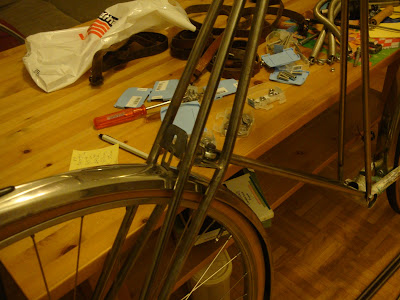For the frame of my Pedersen I planned a bolted construction recycling the bottom bracket with chain stays of the donor bike. By recycling this module I can rely on the rigidity and correct alignment of the original donor bicycle dropouts without, literally, reinventing the wheel. The bolted feature is an old idea of mine which might be questioned by many fellow Pedersen builder enthusiasts: why to compromise the resistance and rigidity of a solidly throughout brazed frame, by including some bolted joints?
A few points on my behalf in the following:
The Pedersen frame concept relies in a truss construction. A truss construction by definition consists in individual elements jointed at nodes. These elements are subjected either to tensile or compressive stresses, but no flexural moments are taken by the elements, as the rotational degree of freedom in the nodes is not restricted. The fact that the nodes take no bending efforts, makes the resolution of the structural system relatively simple, as all loads are applied to the nodes and all elements are just subjected to tensile-compressive stresses without complex stresses as shear, bending and torsion.
Therefore, solidly brazing at a certain node the different elements in a specific position , would go completely against the very essence of a truss construction. The nodal equations for bending moments would be no longer zero and this would render useless the standard calculation procedure to resolve such a truss structural system.
A caveat, though: this specific truss structure of the Pedersen frame is statically indeterminate. For a truss system to be statically determinate, there is a certain relationship between number of members, nodes and degrees of freedom in the fixation restrains of the structure, which must be kept. When there are excess of members to the minimum necessary, so to speak, the system can not be resolved by the sole application of Newton's equations of mechanical equilibrium. In such cases more involved resolution methods are necessary.
In this case, even if I fully trust old Mikael Pedersen, I used the demo version of the following software
http://www.masoftware.se/index.htmlIt is a very effective software for truss calculation with a user-friendly interface. My temporary license expired and I did not do any screenshots, so you might have to believe me that the stresses and deflections in my frame are acceptable.
The following picture, illustrates very well the tensional stresses taken by the gentlemen's arms and the compressive stresses taken by the bars fixed to the chairs.

Another point to justify the bolted construction is that I wanted a modular type of bicycle that can be dissassembled for travelling, say by train or by plane, taking the space of a normal piece of luggage. The modular concept would allow for future changes in the frame: different fork, alteration of members for different frame geometry, or even expanding the concept to a tandem.
After all this preliminary digression, back to the workshop...
Here is the bracket and chain stays assembly from the donor bike. My intention now is to fabricate in this part the fixation points to attach this module to the rest of my frame.

As a first step I drilled a hole through the base of the original seat tube. Care has to be taken that it is perfectly perpendicular to the longitudinal axis.

Careful filing to fit a 10mm tube with 1mm wall thickness.

Here is how it looks like immediately after brazing both tubes in place. You might have observed that the front tube is shorter than the rear. The reason is that in the front joint both the beams connected to the head tube and to the fork bracket are to be fixed. On the other hand, in the rear tube only the seat stays will be fixed.

The next step was to fabricate the fixation points at the rear dropouts, to fix the frame members that connect with the head tube. The parts were turned in the lathe, drilled and filed, as you see in the next picture.

This is how the fixation points look brazed in place.





























